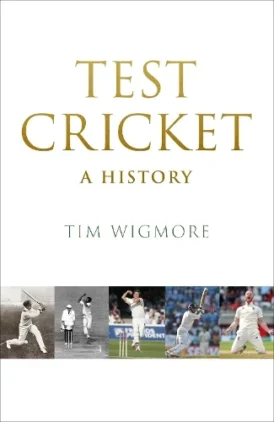Test Cricket: A History
Martin Chandler |Published: 2025
Pages: 578
Author: Wigmore, Tim
Publisher: Quercus
Rating: 4 stars

By the time I started school the die was already cast and, strange child that I was, I had already fallen under cricket’s spell and started to spend long hours poring over my father’s modest collection of post was Wisdens. My parents no doubt seeking to encourage this interest it wasn’t too long before A History of Cricket appeared in the house.
That was a book co-written by Jim Swanton and Harry Altham, and had been published originally way back in 1926. By the time of the 1962 edition, the one we had, it had become two substantial volumes. It may have come as a disappointment to my parents, but as a small child that was actually far too much for me and I stuck to reading Wisden. By the time I was interested in doing more than studying scorecards, statistics and brief pieces of narrative neither volume of A History of Cricket was anywhere to be seen and despite having reacquired it some years ago it remains a book that I have never actually read.
Since 1962 there have, rather to my surprise, been a number of other books published with similar titles, none of them entirely satisfying because the subject is now so vast, there being another sixty plus years to add to the story, not to mention new formats, an increased geographical spread and the development of the women’s game.
Bearing that in mind Tim Wigmore was wise to limit his endeavours to a history of just one aspect of the game, Test cricket. Even then however he has produced a mighty tome, hardly surprisingly given that the recent encounter at Trent Bridge between England and Zimbabwe was Test number 2,584. The best way of putting that in context is by looking back at Swanton and Altham again, and the first Test of the English summer of 1962 was the 530th.
There was therefore a lot of ground to cover, and the first question to ask is who exactly is Tim Wigmore. I have reviewed one of his previous books, Second XI, an excellent collaboration with Peter Miller on the subject of the game beyond the major Test nations. He has also co-written Cricket 2.0: Inside the T20 Revolution as well as England’s double World Champions of 2019. Not being a great enthusiast for the game’s white ball formats I let those two pass me by, and I have also not read Crickonomics, a book that I fear might depress me.
The above said now that I have read the introduction to Test Cricket: A History I must make a point of going back to look at those three titles I have not previously looked at. Part of the reason for that is that Wigmore is a very good writer, although of course I already knew that having read Second XI. What I didn’t know then is that Wigmore values Test cricket as much as I do, and the explanation of its importance that that introduction contains is as lucid a piece of writing on that subject as anything I have ever read.
And indeed the entire book is well written and well researched by a man who has clearly thoroughly researched his subject. There are no statistics, which is just as well as it isn’t that sort of book, and there is a decent index, something any non fiction book benefits from. But who should buy it?
Up until about half a century ago, and well beyond that for Ashes contests, almost all Test series were covered by books as well as by newspapers and magazines. They also tended to be less frequent than now and, for the true cricket tragic, there really isn’t anything that Wigmore can say that we don’t already know. On the other hand those who are unfamiliar with the subject will soon find themselves engrossed in the story of how Test cricket has got to where it is today.
Which might be interpreted as meaning this is a book for novices only, but despite those comments I wouldn’t say that is the case at all. For many years now, and despite all the doom and gloom surrounding the format’s future, there has been no let up in the amount of Test cricket played and the reality is, now that tour books are so rare, that it isn’t always easy to keep up with all the Test cricket going on in the world.
One result of that inability to keep up, beyond watching matches unfold through their scorecards, is that I got rather more out of the later chapters in the book than the early ones. It was particularly enjoyable, for example, to read about the long road that Bangladesh have taken from being the whipping boys of the international game to, at last, being competitive.
That is something Wigmore could have achieved in the internet age without leaving the comfort of his office, so perhaps the real bonus of Test Cricket: A History is that he chose not to do that and to go out and talk to players to get their input. The acknowledgments contain a list of the great and the good of the modern game that numbers well over forty. One of them is Ajinkya Rahane, whose memories of 36 all out and its aftermath make the chapter entitled Cricket’s Superpower one of the best in the book, and certainly my personal favourite.
For his previous books Wigmore has always had a co-author, so this is his first solo effort and the result is an excellent guide to cricket’s gold standard format and one which will, surely, attract the attention of those who favour the game’s shorter versions to the delights they are denying themselves.






Leave a comment